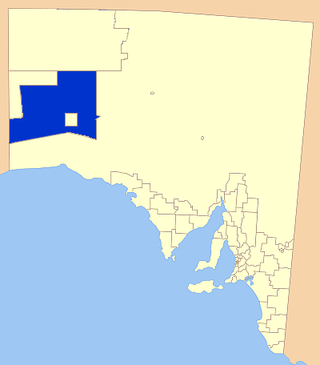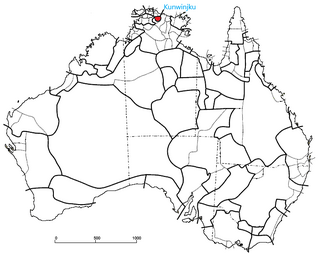
The Wirangu are an Aboriginal Australian people of the Western coastal region of South Australia.

The Wirangu are an Aboriginal Australian people of the Western coastal region of South Australia.
Daisy Bates stated that the Wirangu ethnonym was composed of two words: wira (cloud) and wonga (speech). [1]
Wirangu is usually classified as genetically related to the Thura-Yura language family. Early ethnographers, such as R. H. Mathews stated that the Barngarla, Nauo and Wirangu peoples were "practically the same people in language and customs". [2]
In Norman Tindale's estimation, the Wirangu were assigned an original tribal land extending over 21,500 square miles (56,000 km2), embracing the coastal area between Head of Bight, Cape Blanche and Streaky Bay, with an inland extension running north to places like Ooldea, Kokatha, and Kondoolka. [3]
In ancestral times a large mother snake travelled down from the west to Juldi'kapi. From there it was followed by two men (the Wati Kutjara) [lower-alpha 2] who wished to kill it. They chased the snake south-east to Pedinga water-hole (Pedinga'kapi, thirty-five miles south-east of the Ooldea Soak). This granite water-hole was the snake's camp. The natural basin-shaped depressions in the rock, averaging three feet in diameter, are said to be the nests of snakes. Here the Wati Kutjara speared the snake, wounding it severely. They left it thus, thinking that it would soon die, and returned to the west. The snake, however, managed to crawl on a little distance (about two miles) to the south to an ochre pan, named Mul'tan'tu. Here she rested, leaving the red, yellow and white ochre deposits found there. The red ochre symbolizes the blood shed by the snake, the white ochre the excreta; while the yellow ochre is the urine. The snake left this clay-pan and continued on to the north-east and then westwards to her camp. [5]
Already on the eve of contact with whites, the Wirangu were being pressured out of part of their traditional territory by the movements of the Kokata. [3]
Source: Tindale 1974 , p. 219

The Maralinga Tjarutja, or Maralinga Tjarutja Council, is the corporation representing the traditional Anangu owners of the remote western areas of South Australia known as the Maralinga Tjarutja lands. The council was established by the Maralinga Tjarutja Land Rights Act 1984. The area is one of the four regions of South Australia classified as an Aboriginal Council (AC) and not incorporated within a local government area.

The Wirangu language, also written Wirrongu, Wirrung, Wirrunga, and Wirangga, and also known by other exonyms, is a moribund Australian Aboriginal language traditionally spoken by the Wirangu people, living on the west coast of South Australia across a region encompassing modern Ceduna and Streaky Bay, stretching west approximately to the head of the Great Australian Bight and east to Lake Gairdner. It is a language of the Thura-Yura group, and some older sources placed it in a subgroup called Nangga.
The Ngadjuri people are a group of Aboriginal Australian people whose traditional lands lie in the mid north of South Australia with a territory extending from Gawler in the south to Orroroo in the Flinders Ranges in the north.

The Nauo language, also commonly written Nawu, is an extinct and little-recorded Australian Aboriginal language that was spoken by the Nauo people on the southern part of the Eyre Peninsula, South Australia. However, work on the reconstruction of the language by the Mobile Language Team at Adelaide University is proceeding.
Nukunu are an Aboriginal Australian people of South Australia, living around the Spencer Gulf area. In the years after British colonisation of South Australia, the area was developed to contain the cities of Port Pirie and Port Augusta.

The Kunwinjku people are an Australian Aboriginal people, one of several groups within the Bininj people, who live around West Arnhem Land to the east of Darwin, Northern Territory. Kunwinjku people generally refer to themselves as "Bininj" in much the same way that Yolŋu people refer to themselves as "Yolŋu".
The Erawirung people, also known as Yirau, Juju and other names, were an Aboriginal Australian people whose traditional territory was located in what is today the Riverland of South Australia. They consisted of sub-groups or clans, including Jeraruk, Rankbirit and Wilu, and have been referred to as Meru people, which was a larger grouping which could also include the Ngawait and Ngaiawang peoples.
The Barungguan are an Aboriginal Australian people of the Cape York Peninsula of Northern Queensland. The name is associated with three languages: Ganganda, Umpithamu and Morrobolam.
The Murunitja are an indigenous Australian tribe of Western Australia located within the Goldfields-Esperance region.
The Ngalia, or Ngalea, are an Aboriginal Australian people of the Western Desert cultural bloc resident in land extending from Western Australia to the west of South Australia. They are not to be confused with the Ngalia of the Northern Territory.

The Arabana, also known as the Ngarabana, are an Aboriginal Australian people of South Australia.
The Tjalkadjara or Tjalkanti were an indigenous Australian tribe of Western Australia.
The Kokatha, also known as the Kokatha Mula, are an Aboriginal Australian people of the state of South Australia. They speak the Kokatha language, close to or a dialect of the Western Desert language.
The Yankunytjatjara people, also written Yankuntjatjarra, Jangkundjara, and other variants, are an Aboriginal Australian people of the state of South Australia.
The Antakirinja, otherwise spelt Antakarinya, and alternatively spoken of as the Ngonde, are an indigenous Australian people of South Australia.
The Kuyani people, also written Guyani and other variants, and also known as the Nganitjidi, are an Aboriginal Australian people of the state of South Australia who speak the Kuyani language. Their traditional lands are to the west of the Flinders Ranges.
The Wangkangurru, also written Wongkanguru and Wangkanguru, are an Aboriginal Australian people of the Simpson Desert area in the state of South Australia. They also refer to themselves as Nharla.
The Wailpi are an indigenous people of South Australia They are also known as the Adnyamathanha, which also refers to a larger group, though they speak a dialect of the Adnyamathanha language.

The Nauo people, also spelt Nawu and Nhawu, are an Aboriginal Australian people of the south-western Eyre Peninsula in South Australia. The Nauo language became extinct by the twentieth century, but efforts are being made to revive it.

The Kokatha language, also written Kukatha, Kokata, Gugada, and other variants, and also referred to as Madutara, Maduwonga, Nganitjidi, Wanggamadu, and Yallingarra and variant spellings of these, is an Australian Aboriginal language of the Western Desert group traditionally spoken by the Kokatha people, whose traditional lands are in the western part of the state of South Australia, north of the Wirangu people.